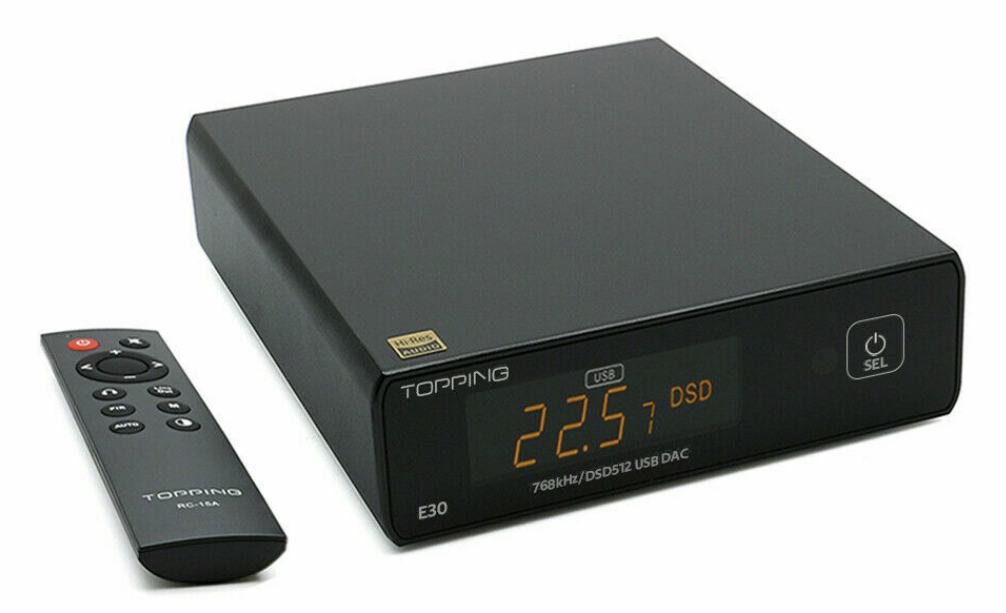Add a Topping E30 USB DAC
This project is to add a Topping E30 USB DAC to piCorePlayer.

What was used
Hardware
- Raspberry Pi 4B - 1GB.
- Raspberry Pi 15.3W USB-C Power Supply.
- SanDisk Ultra 8GB SD card—see SD card.
- Topping E30 USB DAC—see Topping E30 II.
Warning
The Topping E30 USB DAC is no longer available. The Topping E30 II is the later equivalent.
Software
- piCorePlayer 7.0.0—see piCorePlayer Downloads.
Network Diagram
graph TD
Router[Wifi router]
Router --> |Wifi| RPi[RPi4B - pCP]
RPi --- |USB 2| DAC[Topping E30]
RPi --- |USB 2| DAC[Topping E30]
DAC --> AMP[Amplifier]
DAC --> AMP[Amplifier]
Steps
Step 1 - Download pCP
- Download piCorePlayer—see Download piCorePlayer.
Step 2 - Create SD card
- Create an SD card with piCorePlayer image—see Burn piCorePlayer onto a SD card.
Step 3 - Setup Wifi
- Create wpa_supplicant.conf on boot partition—see Setup Wifi without ethernet.
- Eject the SD card.
Step 4 - Connect Topping E30 USB DAC
- Connect the 2 USB cables (supplied) from the Raspberry Pi USB2 ports to Topping E30.
- Topping E30 was used with default settings.
Step 5 - Boot pCP
- Insert the SD card into the Raspberry Pi.
- Connect power cable.
- Turn the power on.
Step 6 - Determine the IP address
- Determine the IP address—see Determine your piCorePlayer IP address.
Step 7 - Access pCP GUI
- Type
http://<IP address>into web browser, or - Type
http://pcp.localinto web browser.
Step 8 - Select USB audio
- Select [Squeezelite Settings] > “Audio output device settings” > “USB audio”.
- Click [Save].
- This will set “Audio output device settings” to “USB audio” and set “Change Squeezelite settings” to default values.
Danger
“Output setting” will be blanked and will need to be set manually.
Step 9 - Set Output setting
- Click [Squeezelite Settings] > “Change Squeezelite settings” > “Output setting” > “more>”.
- Note the list of available
CARD=E30devices.
Available output devices (click to use):
hw: devices are normally the best choice, but try and decide for yourself:
- null
- sysdefault
- default
- plugequal
- equal
- hw:CARD=E30,DEV=0
- plughw:CARD=E30,DEV=0
- sysdefault:CARD=E30
- front:CARD=E30,DEV=0
- surround21:CARD=E30,DEV=0
- surround40:CARD=E30,DEV=0
- surround41:CARD=E30,DEV=0
- surround50:CARD=E30,DEV=0
- surround51:CARD=E30,DEV=0
- surround71:CARD=E30,DEV=0
- iec958:CARD=E30,DEV=0
- hw:CARD=Headphones,DEV=0
- plughw:CARD=Headphones,DEV=0
- sysdefault:CARD=Headphones- Click on
hw:CARD=E30,DEV=0. - This will set “Output setting” to
hw:CARD=E30,DEV=0. - Click [Save].
Step 10 - Reboot
- Click Reboot when requested.
Step 11 - Play music
- Select track/playlist.
- Play music.
Optional
If you have more than one piCorePlayer, it is recommended that you continue to the following steps.
Step 12 - Set player name
- Access pCP using IP address in a browser (ie. http://192.168.1.xxx or http://pcp.local).
- Select [Squeezelite Settings] > “Change Squeezelite settings” > “Name of your player”.
- Type player name
pCP Topping E30. - Click [Save].
Step 13 - Set hostname
- Select [Tweaks] > “pCP System Tweaks” > “Host name”.
- Type host name
pCPToppingE30. - Click [Save].
- Click [Yes] when requested to “Reboot piCorePlayer”.
Step 14 - Reboot
- Click Reboot when requested.
Notes
- I noticed a couple of “power up” clicks. Not a problem.
Diagnostics
- Check that the Topping E30 USB DAC has been recognised in dmesg.
- Select [Main Page] > [Diagnostics] > [Logs] > “dmesg”.
- Click [Show].
- Search for
Topping.
[ 1.661609] usb 1-1.3: new high-speed USB device number 3 using xhci_hcd
[ 1.792056] usb 1-1.3: New USB device found, idVendor=152a, idProduct=8750, bcdDevice= 1.08
[ 1.792063] usb 1-1.3: New USB device strings: Mfr=1, Product=3, SerialNumber=0
[ 1.792070] usb 1-1.3: Product: E30
[ 1.792076] usb 1-1.3: Manufacturer: Topping
- Check that the “CARD=E30” devices are available.
- Click [Squeezelite Settings] > “Change Squeezelite settings” > “Output setting” > “more>”.
- Search for
CARD=E30.
Available output devices (click to use):
hw: devices are normally the best choice, but try and decide for yourself:
- null
- sysdefault
- default
- plugequal
- equal
- hw:CARD=E30,DEV=0
- plughw:CARD=E30,DEV=0
- sysdefault:CARD=E30
- front:CARD=E30,DEV=0
- surround21:CARD=E30,DEV=0
- surround40:CARD=E30,DEV=0
- surround41:CARD=E30,DEV=0
- surround50:CARD=E30,DEV=0
- surround51:CARD=E30,DEV=0
- surround71:CARD=E30,DEV=0
- iec958:CARD=E30,DEV=0
- hw:CARD=Headphones,DEV=0
- plughw:CARD=Headphones,DEV=0
- sysdefault:CARD=HeadphonesMore information
- Download piCorePlayer
- Burn piCorePlayer onto a SD card
- Setup Wifi without ethernet
- Determine your piCorePlayer IP address
- Topping E30 - homepage—no longer available
- Topping E30 II - homepage—never version of the Topping E30
- LMS could not re-establish any USB connection after USB Dac is disconnected
- Possible issue with Topping E30 DAC
The Software and Information is provided "as is" without warranty of any kind, either express or implied, including without limitation any implied warranties of condition, uninterrupted use, merchantability, fitness for a particular purpose, or non-infringement.
Raspberry Pi is a trademark of the Raspberry Pi Foundation.